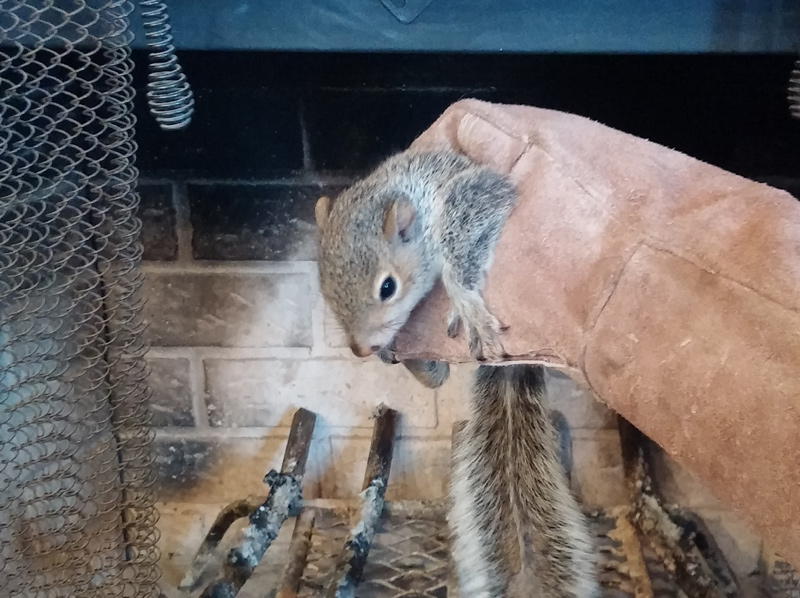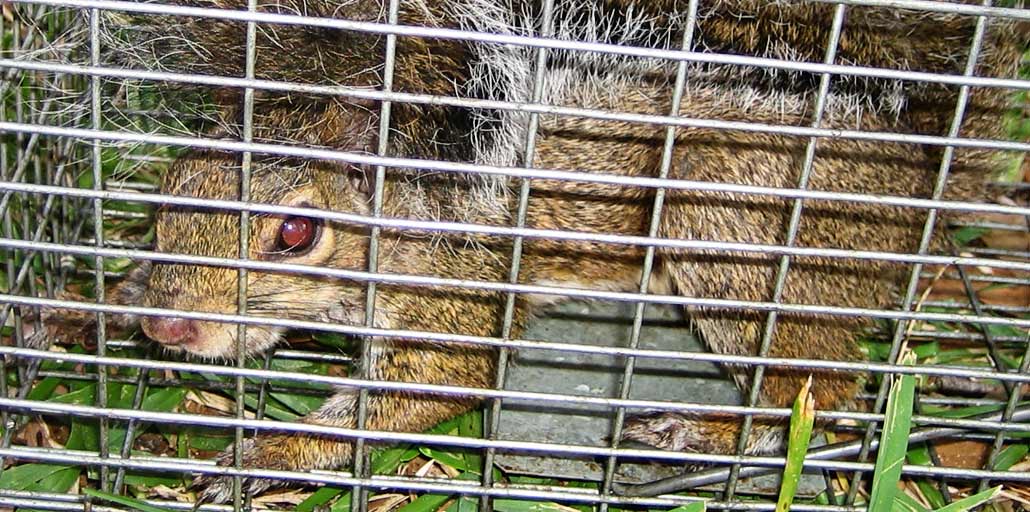- USA Wildlife Removal Education Guide and Resources
Squirrel in the Chimney - What to Do

A chimney is a great place for a squirrel to live. Like a big, hollow tree! Most commonly, a squirrel in a chimney is a female, who wants a safe place to have a nest of baby squirrels. Squirrels are amazing climbers. In some instances though, a squirrel will actually fall down a slick metal chimney flu, and get stuck. Here is what to do:
- If a squirrel fell down a chimney and can't climb out, you need to either open the flu and let it out in your house, or drop a heavy rope down the chimney, all the way to the bottom, so that the animal can climb out.
- If the squirrel(s) are living in the chimney and can climb in and out, you need to remove them. Remember, do not start a fire! That could roast young squirrels alive.
- Set traps at the top of the flu, or install a screen with a one-way exclusion door, which will allow them to exit the chimney, but not get back in.
- If there are baby squirrels above the fireplace that can't climb out, open the damper and remove them by hand, with a thick glove, and bring them outside to mother squirrel.
- Once they are all out, install a steel chimney cap on top of the flu to prevent it from happening again.
How Are They Getting in the Chimney:
Identify where the squirrels are gaining entry into your chimney. This is usually obvious - the top of the chimney, aka the flu! If it's not capped, it's an easy entry hole! But sometimes they can get in other ways. Squirrels will often make the existing holes in your walls and roof bigger until they can get in. They will also get in your house through ventilation systems. Once you have found the places that the squirrels are getting in, you will need to set the traps.
GET HELP: Do you need professional help with a squirrel problem? We have wildlife experts servicing almost every area of the USA! HIRE US IN YOUR TOWN
COSTS: You may want to read more about squirrels or the prices we charge for our services: READ ABOUT OUR SQUIRREL PRICES
Trapping:
Trapping squirrels is not an easy task and it is not even legal in some areas. To ensure that you are not breaking the law, simply call down to the local humane society or the fish and game office and ask if you are allowed to trap squirrels on your property. If you are allowed to trap squirrels you can get both lethal and live traps at a hardware store or rent one from the humane society. Bait the trap with something squirrels like such as peanut butter or fruits. However, traps do not work very well with squirrels because they are hesitation critters and are not likely to fall for the trap.
Install Chimney Cap:
Once you have trapped the squirrels you will need to relocate them no less than 10 to 15 miles away from your house, otherwise they will just come back. Once you have relocated all the squirrels you will then need to go through your home with a keen eye and repair all the holes and vents that they used to get in. When it comes to the chimney, the simplest and most obvious thing to do is to install a steel chimney cap over the flu.
Clean Chimney:
You will also need to clean the areas that the squirrels invaded which is not easy with a chimney, and it can be hazardous. Squirrel urine and droppings smell horribly and will seep into the wood in your home if it is not cleaned properly. Also, squirrels will rip up insulation and you will most likely have to repair it. Squirrels are not easy to catch and it is even more difficult to clean up their bodies and the mess they leave behind. If you even have the smallest amount of doubt, call a professional.
Go back to the main Squirrel Removal page for more information about what to do if you have squirrels in your chimney. Do you hear scratching sounds in the chimney or fireplace? Is there a dead squirrel stuck in the chimney cavity creating a smell or odor? Or maybe a nest of baby squirrel in the chimney. Can they cause damage, and how do you get squirrel out of the chimney?
Squirrels in the Chimney? Squirrels love to nest in a hollow tree and to them the chimney of a house is no different, offering a safe, dry place to live and for the females, to build a nest and bear their kittens. So if you start hearing noises from that direction in the daytime it’s likely that a squirrel has taken up residence.

Not good: if the damper is closed, it provides a great platform for a nest, itself a fire hazard. If the damper is open, it can the squirrel may enter your home and start chewing on your chairs. Too, if you should start a fire on a chilly day, you might cook the animals alive – a terrible end for them and one that leaves your home with a horrible stench.
A chimney cap is the surest way to keep the critters out. But if they’re already in, there are several ways to evict them. Squirrels enter and exit their nesting places multiple times a day to find food and water, so a chimney trap at the top of the flue can corral the adult squirrel. If it’s a mother you can tell by checking her tummy. If there are signs of nursing, you can recover the kittens and relocate the family.
If your squirrel has built a nest above the damper, it will probably fall out if you open it. So before you do, set a ground trap at the base. Alternatively, be ready to grab the critter or snare it when it falls out. If you’ve enclosed the fireplace with a door or screen, set baited humane traps inside and allow the squirrel to catch itself. For bait use something moist and sweet, like fruit.
Repellents can also be effective. Raccoon eviction fluids, such as coyote urine-based products, will often send squirrels packing. You can also try to snare them from above, using a long snare pole, but to do so, you might have to be more nimble than the squirrels.
Squirrels are natural climbers, so masonry chimneys are not problem for them. But it’s not uncommon for one of the animals to get trapped in a slick metal flue. Unable to get a grip and climb back out, rescue is their only option. Wildlife experts usually solve the problem by lowering a weighted, thick rope down the flue, giving the animal a means to climb out.
Squirrels reproduce twice a year, so if one is nesting in your chimney, better get her out or be prepared or a population explosion.
They dislike the aroma of garlic, so placing some strategically around the garden can discourage them from entering
If you need help, we service the entire USA! Click here for a wildlife removal specialist in your town!
Go back to the main Squirrel Removal page for more information about Squirrels in the Chimney.

